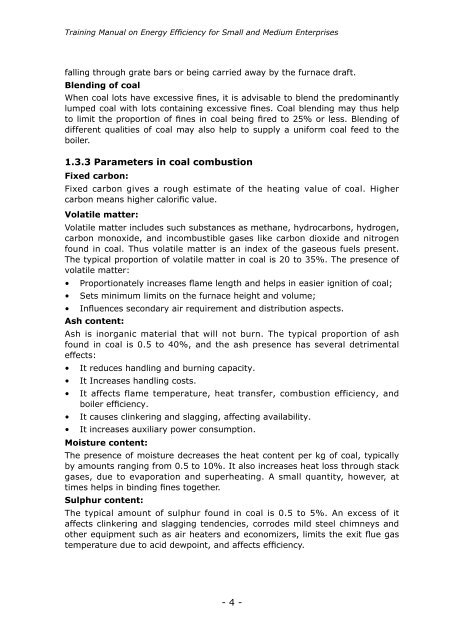Training Manual on Energy Efficiency - APO Asian Productivity ...
Training Manual on Energy Efficiency - APO Asian Productivity ...
Training Manual on Energy Efficiency - APO Asian Productivity ...
Create successful ePaper yourself
Turn your PDF publications into a flip-book with our unique Google optimized e-Paper software.
<str<strong>on</strong>g>Training</str<strong>on</strong>g> <str<strong>on</strong>g>Manual</str<strong>on</strong>g> <strong>on</strong> <strong>Energy</strong> <strong>Efficiency</strong> for Small and Medium Enterprises<br />
falling through grate bars or being carried away by the furnace draft.<br />
Blending of coal<br />
When coal lots have excessive fines, it is advisable to blend the predominantly<br />
lumped coal with lots c<strong>on</strong>taining excessive fines. Coal blending may thus help<br />
to limit the proporti<strong>on</strong> of fines in coal being fired to 25% or less. Blending of<br />
different qualities of coal may also help to supply a uniform coal feed to the<br />
boiler.<br />
1.3.3 Parameters in coal combusti<strong>on</strong><br />
Fixed carb<strong>on</strong>:<br />
Fixed carb<strong>on</strong> gives a rough estimate of the heating value of coal. Higher<br />
carb<strong>on</strong> means higher calorific value.<br />
Volatile matter:<br />
Volatile matter includes such substances as methane, hydrocarb<strong>on</strong>s, hydrogen,<br />
carb<strong>on</strong> m<strong>on</strong>oxide, and incombustible gases like carb<strong>on</strong> dioxide and nitrogen<br />
found in coal. Thus volatile matter is an index of the gaseous fuels present.<br />
The typical proporti<strong>on</strong> of volatile matter in coal is 20 to 35%. The presence of<br />
volatile matter:<br />
• Proporti<strong>on</strong>ately increases flame length and helps in easier igniti<strong>on</strong> of coal;<br />
• Sets minimum limits <strong>on</strong> the furnace height and volume;<br />
• Influences sec<strong>on</strong>dary air requirement and distributi<strong>on</strong> aspects.<br />
Ash c<strong>on</strong>tent:<br />
Ash is inorganic material that will not burn. The typical proporti<strong>on</strong> of ash<br />
found in coal is 0.5 to 40%, and the ash presence has several detrimental<br />
effects:<br />
• It reduces handling and burning capacity.<br />
• It Increases handling costs.<br />
• It affects flame temperature, heat transfer, combusti<strong>on</strong> efficiency, and<br />
boiler efficiency.<br />
• It causes clinkering and slagging, affecting availability.<br />
• It increases auxiliary power c<strong>on</strong>sumpti<strong>on</strong>.<br />
Moisture c<strong>on</strong>tent:<br />
The presence of moisture decreases the heat c<strong>on</strong>tent per kg of coal, typically<br />
by amounts ranging from 0.5 to 10%. It also increases heat loss through stack<br />
gases, due to evaporati<strong>on</strong> and superheating. A small quantity, however, at<br />
times helps in binding fines together.<br />
Sulphur c<strong>on</strong>tent:<br />
The typical amount of sulphur found in coal is 0.5 to 5%. An excess of it<br />
affects clinkering and slagging tendencies, corrodes mild steel chimneys and<br />
other equipment such as air heaters and ec<strong>on</strong>omizers, limits the exit flue gas<br />
temperature due to acid dewpoint, and affects efficiency.<br />
- 4 -
















